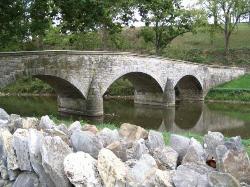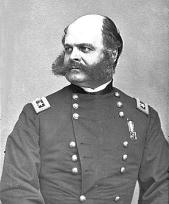
| Answer to Quiz #31- October 16, 2005 Why is this bridge named the "Burnside Bridge"? Where is it located? What historical event occurred at this bridge? |
| Submitted by Sue Ramsey and Dale Niesen. Click on thumbnails to see larger images. |
| Answers: It is named after Civil War General Ambrose E. Burnside. Over Antietam Creek, near Sharpsburg, MD The Battle of Antietam, September 17, 1862. |
| ********** |
| Major General Ambrose E. Burnside http://www.wildwestweb.net/cwleaders/cwleaders.html Trivia: Sideburns were named for Maj. Gen. Burnside. (Hardly surprising.) |
From http://www.eyewitnesstohistory.com/antiet.htm and
http://www.nps.gov/anti/battle.htm
The Bloodiest Battle
General Robert E. Lee's first invasion of the North was a huge gamble that held the
potential of very great rewards. Lee's campaign could win Maryland for the
Confederacy, earn diplomatic recognition from Britain and France, and perhaps even
force the Union to sue for peace. It would also take his troops out of war-ravaged
Virginia during harvest time, and enable his troops to live off the enemy's country for a
while. Following his victory at the Second Battle of Bull Run Lee led his ragtag army
northward across the Potomac River and into Union territory.
The ensuing battle on September 17 produced the bloodiest day in American combat
history with over 23,000 casualties on both sides. Federal losses were 12,410,
Confederate losses 10,700. One in four men engaged in battle that day had fallen. More
than twice as many Americans were killed or mortally wounded in combat at Antietam
that day as in the War of 1812, the Mexican War, and the Spanish-American War
combined. To view the magnitude of the losses, consider that Antietam resulted in nine
times as many Americans killed or wounded (23,000 soldiers) as took place on June 6,
1944--D-day, the so-called "longest day" of World War II.* According to National
Archives data, American casualties at Omaha and Utah beaches on D-Day totaled 2,51.
0Also consider that more soldiers were killed and wounded at the Battle of Antietam
than the deaths of all Americans in the Revolutionary War, War of 1812, Mexican War,
and Spanish-American War combined.
http://www.nps.gov/anti/battle.htm
The Bloodiest Battle
General Robert E. Lee's first invasion of the North was a huge gamble that held the
potential of very great rewards. Lee's campaign could win Maryland for the
Confederacy, earn diplomatic recognition from Britain and France, and perhaps even
force the Union to sue for peace. It would also take his troops out of war-ravaged
Virginia during harvest time, and enable his troops to live off the enemy's country for a
while. Following his victory at the Second Battle of Bull Run Lee led his ragtag army
northward across the Potomac River and into Union territory.
The ensuing battle on September 17 produced the bloodiest day in American combat
history with over 23,000 casualties on both sides. Federal losses were 12,410,
Confederate losses 10,700. One in four men engaged in battle that day had fallen. More
than twice as many Americans were killed or mortally wounded in combat at Antietam
that day as in the War of 1812, the Mexican War, and the Spanish-American War
combined. To view the magnitude of the losses, consider that Antietam resulted in nine
times as many Americans killed or wounded (23,000 soldiers) as took place on June 6,
1944--D-day, the so-called "longest day" of World War II.* According to National
Archives data, American casualties at Omaha and Utah beaches on D-Day totaled 2,51.
0Also consider that more soldiers were killed and wounded at the Battle of Antietam
than the deaths of all Americans in the Revolutionary War, War of 1812, Mexican War,
and Spanish-American War combined.
| The Battle of Antietam |

Wednesday, September 17, 1862 at the Civil War Battle of Antietam, this bridge
received the new name " Burnside's Bridge" after Union Major General Ambrose E.
Burnside ordered his 12,000 strong Ninth Corps to secure this 12 1/2 ft wide bridge to
cross Antietem Creek in their drive to Sharpsburg, Maryland. These troops were held
off for 3 1/2 hours by 450 Georgia riflemen who had taken positions behind trees and
boulders on a steep wooded bluff some 100 feet high and overlooking the Lower
Bridge. The riflemen were a key factor in McClellan's failure at Antietam. Greatly
outnumbered, the Confederates drove back several Union advances toward the bridge,
finally retreating when they ran out of ammunition. This battle was the first major Civil
War engagement on Northern soil.
Finally, at 1 p.m. the Federals crossed the 125-foot-long bridge (now known as
Burnside Bridge) and, after a 2-hour delay to rest and replenish ammunition, continued
their advance toward Sharpsburg. By late afternoon about 8,000 Union troops had
driven the Confederates back almost to Sharpsburg, threatening to cut off the line of
retreat for Lee's army. By 3:30 p.m. many Rebels jammed the streets of Sharpsburg in
retreat. The battle seemed lost to the Southern army. Then at 3:40 p.m. Gen. A. P. Hill's
division, left behind by Jackson at Harpers Ferry to salvage the captured Federal
property, arrived on the field after a march of 17 miles in eight hours. Immediately Hill's
3,000 troops entered the fight, attacking the Federals' unprotected left flank. Burnside's
troops were driven back to the heights near the bridge they had taken earlier. The attack
across the Burnside Bridge and Hill's counterattack in the fields south of Antietam
resulted in 3,470 casualties--with twice as many Union casualties (2,350) as
Confederate (1,120).
Longstreet later wrote, "We were so badly crushed that at the close of the day ten
thousand fresh troops could have come in and taken Lee's army and everything in it."
But again McClellan held the 20,000 men of V Corps and VI Corps in reserve--and lost
a second opportunity to defeat the entire Confederate army. By 5:30 p.m., the Battle of
Antietam was over.
The Aftermath
The next day Federal and Confederate leaders struck up an informal truce, so they
could begin gathering up the wounded and dying. During the evening of the 18th Lee
began withdrawing his army across the Potomac River.
Some historians believe that Lee's failure to carry the war effectively into the North
caused Great Britain to postpone recognition of the Confederate government. The battle
also gave President Abraham Lincoln the opportunity to issue the Emancipation
Proclamation which, on January 1, 1863, declared free all slaves in states still in
rebellion against the United States. Now the war had a dual purpose: to preserve the
Union and to end slavery.
Burnside was criticized for not having his men wade across the stream in a different
location. However,in 1994, 25 West Point cadets tried wading across and found that
the steep banks would have created difficulties and resulted in a greater loss of life. The
bridge is the battlefield's best-known landmark. It was previously known as the
Rohrback Bridge or Lower Bridge over Antietam Creek.
received the new name " Burnside's Bridge" after Union Major General Ambrose E.
Burnside ordered his 12,000 strong Ninth Corps to secure this 12 1/2 ft wide bridge to
cross Antietem Creek in their drive to Sharpsburg, Maryland. These troops were held
off for 3 1/2 hours by 450 Georgia riflemen who had taken positions behind trees and
boulders on a steep wooded bluff some 100 feet high and overlooking the Lower
Bridge. The riflemen were a key factor in McClellan's failure at Antietam. Greatly
outnumbered, the Confederates drove back several Union advances toward the bridge,
finally retreating when they ran out of ammunition. This battle was the first major Civil
War engagement on Northern soil.
Finally, at 1 p.m. the Federals crossed the 125-foot-long bridge (now known as
Burnside Bridge) and, after a 2-hour delay to rest and replenish ammunition, continued
their advance toward Sharpsburg. By late afternoon about 8,000 Union troops had
driven the Confederates back almost to Sharpsburg, threatening to cut off the line of
retreat for Lee's army. By 3:30 p.m. many Rebels jammed the streets of Sharpsburg in
retreat. The battle seemed lost to the Southern army. Then at 3:40 p.m. Gen. A. P. Hill's
division, left behind by Jackson at Harpers Ferry to salvage the captured Federal
property, arrived on the field after a march of 17 miles in eight hours. Immediately Hill's
3,000 troops entered the fight, attacking the Federals' unprotected left flank. Burnside's
troops were driven back to the heights near the bridge they had taken earlier. The attack
across the Burnside Bridge and Hill's counterattack in the fields south of Antietam
resulted in 3,470 casualties--with twice as many Union casualties (2,350) as
Confederate (1,120).
Longstreet later wrote, "We were so badly crushed that at the close of the day ten
thousand fresh troops could have come in and taken Lee's army and everything in it."
But again McClellan held the 20,000 men of V Corps and VI Corps in reserve--and lost
a second opportunity to defeat the entire Confederate army. By 5:30 p.m., the Battle of
Antietam was over.
The Aftermath
The next day Federal and Confederate leaders struck up an informal truce, so they
could begin gathering up the wounded and dying. During the evening of the 18th Lee
began withdrawing his army across the Potomac River.
Some historians believe that Lee's failure to carry the war effectively into the North
caused Great Britain to postpone recognition of the Confederate government. The battle
also gave President Abraham Lincoln the opportunity to issue the Emancipation
Proclamation which, on January 1, 1863, declared free all slaves in states still in
rebellion against the United States. Now the war had a dual purpose: to preserve the
Union and to end slavery.
Burnside was criticized for not having his men wade across the stream in a different
location. However,in 1994, 25 West Point cadets tried wading across and found that
the steep banks would have created difficulties and resulted in a greater loss of life. The
bridge is the battlefield's best-known landmark. It was previously known as the
Rohrback Bridge or Lower Bridge over Antietam Creek.
| ********** |
There is a beautiful photograph of the Burnside Bridge taken in September 1862 by
Alexander Gardner at http://www.sonofthesouth.net/leefoundation/burnside-bridge.htm
See also:
http://www.nps.gov/anti/photos/G_BBridge2.htm
http://www.nps.gov/anti/photos/G_BBridge3.htm
http://www.nps.gov/anti/postcards/Postcards.htm
Alexander Gardner at http://www.sonofthesouth.net/leefoundation/burnside-bridge.htm
See also:
http://www.nps.gov/anti/photos/G_BBridge2.htm
http://www.nps.gov/anti/photos/G_BBridge3.htm
http://www.nps.gov/anti/postcards/Postcards.htm
| ********** |
| Congratulations to our winners! Kenneth Smith D. Dineen Bill Burrows Donald Schulteis Gus Janssen Debbie Anderson Barbara Cangiamilla Mary E. South Mary Fraser Debbie Hinz Marilyn Hamill-Stewart Pat Snyder Maureen O'Connor Robert E. McKenna Stan Read Margaret Garza Julie McCormick Rick McKinney Linda Dean If I have omitted your name from the list of winners, let me know. It was unintentional. |
| If you enjoy our quizzes, don't forget to order our book! Click here. |
If you have a picture you'd like us to feature a picture in a future quiz, please
email it to us at CFitzp@aol.com. If we use it, you will receive a free analysis of
your picture. You will also receive a free Forensic Genealogy CD or a 10%
discount towards the purchase of the Forensic Genealogy book.
email it to us at CFitzp@aol.com. If we use it, you will receive a free analysis of
your picture. You will also receive a free Forensic Genealogy CD or a 10%
discount towards the purchase of the Forensic Genealogy book.
| Quiz #31 Answer |





